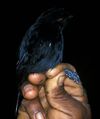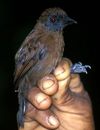Genus Thamnophilus

White-shouldered Antshrike - The White-shouldered Antshrike is a species of bird in the Thamnophilidae family. It is found in Bolivia, Brazil, Colombia, Ecuador, Peru, and Venezuela. Its natural habitat is subtropical or tropical moist lowland forests.
Amazonian Antshrike - Its natural habitats are subtropical or tropical moist lowland forests and subtropical or tropical swamps.
Thamnophilus ambiguus - It occurs at low levels in forest and woodland, especially, but not exclusively, humid.
Western Slaty-Antshrike - It was previously included in the widespread Slaty Antshrike , but following the split, this scientific name is now restricted to the Guianan Slaty-Antshrike.
Black-hooded Antshrike - The Black-hooded Antshrike is a species of bird in the Thamnophilidae family. It is found in Costa Rica and Panama. Its natural habitats are subtropical or tropical moist lowland forests, subtropical or tropical mangrove forests, and heavily degraded former forest.
Variable Antshrike - The Variable Antshrike is a thickset bird with a total length of approximately 14-16 cm . The male has black wings with grey edging to the remiges , and white wing-bars that may appear spotty, especially on the lesser wing coverts. The tail is black with white tips . In the eastern, central and southern subspecies, the chest and most of the head are grey, the back is grey with variable amounts of black , a semi-concealed white interscapular patch, and the crown is black . The variation in the colour of the belly and crissum is highly complex, ranging from white in some subspecies, over grey in others, to deep cinnamon. The male of the western subspecies melanochrous from the Andes of Peru is strikingly different, being overall black except for the white in its wings and tail. The male of the subspecies aspersiventer of the Andes in north-western Bolivia and adjacent Peru approaches melanochrous in colour, but has dense white barring to the belly.
Castelnau's Antshrike - The Castelnau's Antshrike is a species of bird in the Thamnophilidae family. It is found in Brazil, Colombia, Ecuador, and Peru. Its natural habitats are subtropical or tropical moist lowland forests and heavily degraded former forest.
Thamnophilus divisorius - It was discovered in 1996 in the Acre Arch uplands in the state of Acre in Brazil, and described as a species new to science in 2004.
Barred Antshrike - The Barred Antshrike is typically 16.5 cm long, and weighs 25 g. The male is barred all over with black and white, and has a white-based black crest that is raised in display. The female is rufous above with a chestnut crest. The sides of her head and neck are streaked with black, and the underparts are rich buff.
Streak-backed Antshrike - Its natural habitat is subtropical or tropical moist montane forests.
Bar-crested Antshrike - It is found in Colombia and Venezuela. Its natural habitats are subtropical or tropical dry forests, subtropical or tropical moist montane forests, and heavily degraded former forest.
Mouse-coloured Antshrike - It is found in Bolivia, Brazil, Colombia, Ecuador, French Guiana, Guyana, Peru, Suriname, and Venezuela. Its natural habitat is subtropical or tropical moist lowland forests.
Black Antshrike - It is found in Colombia and Panama. Its natural habitats are subtropical or tropical moist lowland forests and heavily degraded former forest.
Blackish-grey Antshrike - The species is found in Brazil, Colombia, Venezuela, and eastern French Guiana; also a small river region of northeast Bolivia. Its natural habitats are subtropical or tropical moist lowland forests and subtropical or tropical swamps. It got its name "Blackish-grey Antshrike" because of its blackish-grey color, distinguishing it from other Antshrikes.
Chestnut-backed Antshrike - Its natural habitats are subtropical or tropical moist lowland forests, subtropical or tropical moist montane forests, and heavily degraded former forest.
Thamnophilus pelzelni - Its occurs at low levels in forest and woodland, especially in areas with dense growth.
Cocha Antshrike - Its natural habitat is subtropical or tropical swamps. It is threatened by habitat loss.
Northern slaty antshrike - The Northern Slaty-Antshrike is found in north-eastern South America in Brazil, Venezuela and the Guianas. In Brazil, it occurs in the northeast quadrant of the Amazon Basin, , and from the Brazilian state of Roraima in the west, to the states of Pará, and Amapá on the Atlantic at the Amazon River outlet. The species occurs only north of the Amazon. A disjunct population exists along the eastern slope of the Andes in Colombia and Venezuela, while two other populations exist in the drainage of the Huallaga and the Marañón River in northern Peru and far southern Ecuador. The populations in Peru and Ecuador are sometimes considered a separate species, the Marañón or Peruvian Slaty-Antshrike , in which case the common name of the remaining species often is modified to Eastern or Guianan Slaty-Antshrike.
Plain-winged Antshrike - The Plain-winged Antshrike is a species of bird in the Thamnophilidae family. It is found in Bolivia, Brazil, Colombia, Ecuador, and Peru. Its natural habitats are subtropical or tropical moist lowland forests and subtropical or tropical swamps.
Thamnophilus stictocephalus - Its natural habitats are subtropical or tropical dry forests and subtropical or tropical moist lowland forests.
Thamnophilus sticturus - It occurs at low levels in forest and woodland; especially in places with dense growth.
Thamnophilus tenuepunctatus - It is found in Colombia, Ecuador, and Peru.
Uniform Antshrike - The Uniform Antshrike is a species of bird in the Thamnophilidae family. It is found in Colombia, Ecuador, and Peru. Its natural habitat is subtropical or tropical moist montanes.
Thamnophilus zarumae - Its natural habitat is subtropical or tropical dry forests.






